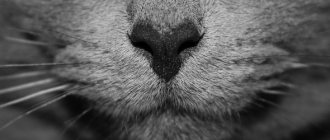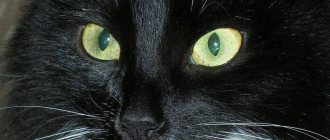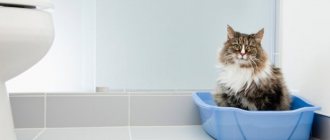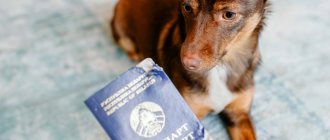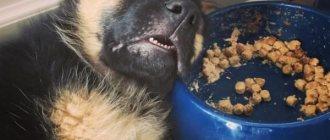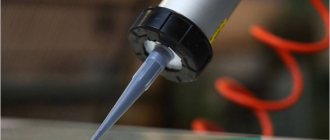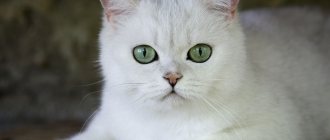Normally, a cat's feces are dark brown, well-formed, and look like a smooth sausage without foreign inclusions. But sometimes the color of stool for some reason becomes too dark or light, foul-smelling, liquid or hard. In such a situation, you should monitor the pet’s behavior, because often suspicious feces indicate the occurrence of a dangerous disease in the body, which cannot be started.
What's the normal color?
Feces in cats, like in humans, can tell everything about their health. The cat poops in dense, well-formed masses that are brown or dark brown in color. The consistency of excrement depends on the content of liquid, fat, and mucous components. The smell of feces is not unpleasant, not strong, this smell is called feces. If the diet is dominated by dairy and fermented milk products, cereals, and vegetables, the mass acquires a light brown tint. When a pet eats mainly meat, the excrement becomes a more saturated dark color.
Nutrition
Let's start with the last reason. A question that Murok and Barsikov owners often ask is whether cats can have raw meat? They can do anything, but their usefulness is in question. Cats and cats are allowed to eat raw meat in small quantities. Just before you treat your pet to something tasty, you need to defrost and scald the product with boiling water.
The reasons for black feces in cats lie in overeating meat. When the pet has enjoyed a hearty meal the day before, the owner will receive a surprise in the morning. In this case, panic is not appropriate, because there is nothing terrible. A completely normal reaction of the body to “overeating” raw meat.
By the way, if the animal takes any nutritional supplements containing iron, then black feces are completely normal. The same can be said for foods high in iron.
Reasons for changes
If the color is dark
Very dark, almost black stool with an unpleasant odor indicates digestive problems. If food is not fully digested in the stomach and intestines, fermentation processes soon develop in these organs. Food particles rot, pathogenic microflora actively multiply, which is why the animal develops black stool.
Green color
Often, stool becomes like this due to the use of antibiotics by animals.
Dark green stool is often a symptom of ulcerative colitis or indicates liver problems. In the latter case, the cause is the presence of bilirubin in the stool, which should normally be absent. Green feces often appear in pets undergoing treatment with antibacterial agents. However, upon completion of therapy, the color should return to normal; if this does not happen, it is necessary to urgently show your pet to a veterinarian.
Light color
Pale, smelly, grayish feces appear in a kitten or adult cat due to the progression of inflammation of the gallbladder and ducts. Another reason why stool becomes pale is viral infectious diseases leading to liver dysfunction. Worm infestation also often contributes to constipation and the presence of depigmented excrement.
Light-colored feces occur in cats whose intestinal evacuation function is increased. As a result of the active promotion of chyme, it is not fully processed by gastric and intestinal juices. At the exit, the mass remains light because the nutrients from it are not completely adsorbed.
Melena or black mass
When there is gastric bleeding, the pet feels weak.
Often, black feces in a cat indicate extensive internal bleeding localized in one of the upper parts of the stomach. In this case, the blood enters the digestive organs and is processed there by enzymes. Melena is usually not the only symptom of the disorder. Along the way, the cat exhibits the following symptoms:
- nausea, vomiting;
- weakness;
- deterioration of general condition;
- heat;
- fainting or coma.
Other shades
Cat feces may also have the following colors:
Redness in the stool is characteristic of bleeding in the intestinal area.
- Red. If the black color of excrement indicates gastric bleeding, then red is evidence of intestinal bleeding. Feces can be solid or liquid, it all depends on the nature of the disease.
- Yellow. Speaks of gastric dysfunction and lack of enzymes involved in food digestion.
- Orange. Often indicates liver disease, accompanied by increased production of bilirubin. In addition, feces may turn orange due to your pet eating food with chemical dyes.
Black feces in a kitten
If an adult cat is sick, this is bad. But if a little kitten gets sick, it can end tragically for his life. The normal color of a kitten's stool should be brown. If the stool turns black, diarrhea with mucus or constipation appears, it means that the pet’s digestive system is not functioning well. The reason may be:
- stress;
- transition from cat milk to adult food;
- binge eating;
- allergic reaction to products;
- infectious diseases.
Accompanying signs: the kitten refuses to eat, its stomach is swollen, the stool contains mucus and blood, loose stools that have an unpleasant odor and are black.
Diagnostic methods
To understand the reason for the change in the properties of excrement in an animal, it can undergo gastroscopy.
Before you begin to treat a disease, it is necessary to find out its causes and establish an accurate diagnosis. Therefore, you cannot do without a visit to the doctor. During the initial examination, the doctor will ask the owner how long the animal has been suffering from this condition, what other symptoms are present, and collect other important information. To confirm the diagnosis, a referral is given for the following additional diagnostic procedures:
- urine and blood analysis;
- biochemistry;
- microscopic examination of feces;
- radiography;
- Ultrasound of internal organs;
- gastroscopy.
What to feed a cat during diarrhea
Note that in the first day after the onset of diarrhea, the pet should be put on a starvation diet, without restricting water. Such a “fast” is needed so that during the rest period the animal’s digestive system returns to normal.
But still, what should you feed your pet so as not to burden its gastrointestinal tract, but at the same time not starve it? Even among experienced veterinarians and breeders there are many opinions on this matter, but the “average optimal value” can be deduced from their recommendations:
Boiled rice. It is best to use round varieties, boiling the product to a semi-liquid pulp. This consistency has a positive effect on the condition of the long-suffering intestinal mucosa without further irritating it. The pet should be fed this for the first day or two.
Chicken bouillon. The better the cat becomes, the more saturated broths can be used. We warn you once again that at first it is extremely undesirable to use fatty foods, as they will almost certainly cause a violent relapse of diarrhea.
Boiled chicken. It is advisable to use the breast as the least fatty part. It is necessary to constantly monitor the cat’s well-being and, if signs of stool liquefaction appear, reduce the amount of meat in its food.
High-quality low-fat by-products
But this must be done as carefully as possible, starting from the first week after the last attack of diarrhea.
Finally, to relieve bouts of diarrhea, you can use pumpkin puree from baby food. The dose is approximately half a teaspoon at a time. The duration of submission is approximately three days.
What treatment is prescribed?
Medication
Depending on the diagnosis, the veterinarian selects the most optimal treatment regimen, which often includes the following groups of drugs:
Dicynone is able to stop a minor source of bleeding in an animal.
- Hemostatic. If diagnostics show that the cat is developing internal bleeding, but it is not life-threatening, the doctor will prescribe medications that can prevent the loss of vital fluid. Effective drugs in this group: “Dicinon”;
- "Tranexam";
- "Vikasol".
- "Penicillin";
- "Interferon";
- "Pyrantel";
- "Maalox";
Surgical
Sometimes surgery is the only option for an animal to return to normal.
Sometimes it is impossible to normalize a pet’s condition with medications alone, for example, with heavy internal bleeding. To save the animal's life, the doctor decides to perform surgical treatment. The manipulations are performed under general anesthesia. After the operation, a long recovery will be required, during which it is important for the owner to control the diet of his four-legged friend, as well as give him medications prescribed by the doctor to prevent the development of inflammatory processes and increase the body's defenses.
Diarrhea symptoms
If the color of the bowel movements deviates from the norm, and your pet is losing a lot of hair, you should consult a specialist.
Cat feces that differ from the norm in color and consistency are already a pathological sign, indicating that not everything is in order with the pet’s body. Other symptoms that require immediate action:
- violation of general condition;
- nausea accompanied by vomiting;
- weakness, drowsiness, apathy;
- increased gas formation;
- persistent constipation or, conversely, diarrhea;
- increased body temperature;
- abdominal pain on palpation;
- blanching or yellowing of the mucous membrane;
- dullness and excessive hair loss;
- lack of appetite;
- rapid weight loss.
Regardless of the etiology (i.e. origin) of diarrhea, all its types can be divided into two large types:
- Acute diarrhea.
- Chronic diarrhea.
Accordingly, the symptoms of these two varieties will differ significantly.
In this case, everything is quite simple and clear. First, you need to decide on the terminology: “acute” diarrhea is called in cases where it began suddenly and lasts no more than two days, accompanied by a significant deterioration in the condition of the sick animal.
The following signs of such diarrhea are distinguished:
Defecation is frequent, the animal constantly runs to the tray.
As a rule, feces are liquid; they often contain impurities in the form of mucus, half-digested pieces of food, and sometimes blood can be seen.
After just five or six trips to the potty, the animal begins to meow hoarsely, constantly licking the anus area.
If diarrhea continues for more than two days, the cat becomes noticeably weaker. In the most severe cases, the pet practically stops grooming itself, its fur becomes matted and becomes covered with a crust of dried feces.
In the same cases, severe blanching of all visible mucous membranes is observed. They become dry and sticky to the touch. The skin loses its elasticity, the coat becomes rough and hard.
The following conclusions can be drawn from all of the above:
If diarrhea lasts less than a day, and the general condition of the animal at this time remains stable and does not cause alarm, you can try to cope with diarrhea on your own.
In cases where a cat suffers from diarrhea for more than a day, and its condition is slowly but deteriorating, you should definitely show the animal to a veterinarian
This precaution will probably not be superfluous.
This type of pathology manifests itself somewhat differently:
Diarrhea occurs sporadically, not every day.
Interestingly, cases of diarrhea may well alternate with periods of “impenetrable” constipation.
The cat’s condition “by eye” remains normal, but this impression is wrong. If nothing is done and the true root cause is not identified, the animal will gradually develop exhaustion.
Prevention
To ensure that your cat does not have problems with defecation, and that the color and consistency of feces always corresponds to the norm, it is important to follow simple preventive rules. Once every six months, the animal should be treated with anthelmintic drugs and treated for cat lice and fleas. In addition, it is worth adjusting the diet and, if necessary, switching to ready-made medicinal factory feed. If your pet's stool stinks and has an uncharacteristic color, it is forbidden to self-medicate. Only a treatment regimen correctly selected by a doctor will help eliminate the disease and prevent complications.
Care
The main goal of therapy is to treat the underlying disease, including kidney, liver and lung diseases. Successful treatment should eventually resolve the black stool problem. Fluid therapy will be given to replenish fluid levels in the body, and whole blood transfusions may be required in some patients with severe blood loss and anemia. Patients who experience persistent vomiting will require medications to control the vomiting and allow them to hold onto food long enough to digest it. Severe ulcers or tumors in the gastrointestinal tract may require surgery.
When a visit to the vet should not be postponed
Urgent veterinary care is needed for your pet when the following additional symptoms occur:
- stomach ache;
- plaintive meow;
- temperature above 40 °C;
- diarrhea;
- vomit;
- refusal to eat;
- blood clots in excrement.
The most dangerous sign is the appearance of melena - feces with a tarry consistency, indicating large-scale bleeding.
Bristol scale
English doctors at the Royal Hospital in Bristol have developed a simple but unique scale that characterizes all the main types of feces. Its creation was the result of the fact that experts were faced with the problem that people are reluctant to open up about this topic; embarrassment prevents them from talking in detail about their stool.
Based on the developed drawings, it became very easy to independently characterize your own bowel movements without any embarrassment or awkwardness. Currently, the Bristol Stool Shape Scale is used throughout the world to assess the functioning of the digestive system. For many, printing a table (types of feces) on the wall in your own toilet is nothing more than a way to monitor your health.
1st type. Sheep feces
It is called so because it is shaped like hard balls and resembles sheep feces. If for animals this is a normal result of intestinal function, then for humans such stool is an alarm signal. Sheep pellets are a sign of constipation and dysbacteriosis. Hard feces can cause hemorrhoids, damage to the anus, and even lead to intoxication of the body.
2nd type. Thick sausage
3rd type. Sausage with cracks
Very often people consider such stools to be normal, because they pass easily. But make no mistake. Hard sausage is also a sign of constipation. When defecating, you have to strain, which means there is a possibility of anal fissures. In this case, irritable bowel syndrome may be present.
4th type. Ideal chair
5th type. Soft balls
This type is even better than the previous one. A few soft pieces form and come out gently. Usually occurs with a large meal. Stool several times a day.
6th type. Unshaped chair
The feces come out in pieces, but unformed, with torn edges. It comes out easily without hurting the anus. This is not diarrhea yet, but it is already a condition close to it. The causes of this type of stool can be laxative medications, increased blood pressure, excessive consumption of spices, and mineral water.
7th type. Loose stools

